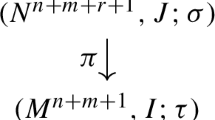Abstract
Determination of the observability/detectability properties of a nonlinear system is fundamental to assess the possibility of constructing observers and the properties that can be assigned to them, as e.g., the assignability of the convergence rate. For linear systems this task can be solved by well-known techniques, for the case without perturbations as much as for the perturbed case. However, for nonlinear systems this study is usually a very hard task, in particular, when unknown inputs and/or perturbations are present. In this paper a general method to study these properties will be described, and its capabilities and feasibility will be assessed by means of a few case studies related to the culture of phytoplankton in the chemostat.



Similar content being viewed by others
References
Bastin G, Dochain D (1990) On-line estimation and adaptive control of bioreactors. Elsevier, Amsterdam
Dochain D, Vanrolleghem PA (2001) Dynamical modelling and estimation in wastewater treatment processes. IWA Publishing, London
Zeitz M (1989) Canonical normal forms for nonlinear systems. In: Isidori A (eds) Nonlinear control systems design. In: Selected Papers from IFAC-Symposium. Pergamon Press, Oxford, pp 33–38
Hammouri H, Tmar Z (2010) Unknown input observer for state affine systems: a necessary and sufficient condition. Automatica 46(2):271–278
Hermann R, Krener AJ (1977) Nonlinear controllability and observability. IEEE Trans Automatic Control 22:728–740
Gauthier JP, Kupka AK (1994) Observability and observers for nonlinear ystems. SIAM J Control Optim 32:975–994
Hautus MLJ (1983) Strong detectability and observers. Linear Algebra Appl 50:353–368
Gauthier J-P, Kupka I (2001) Deterministic observation theory and applications. Cambridge University Press, Cambridge
Isidori A (1995) Nonlinear control systems. 3rd edn. Springer, New York
Moreno J (2001) Existence of unknown input observers and feedback passivity for linear systems. In: Proceedings of the 40th IEEE conference on decision and control. Orlando, Florida, USA, pp 3366-3371
Moreno JA, Dochain D (2008) Global observability and detectability analysis of uncertain reaction systems and observer design. Int J Control 81:1062–1070
Dochain D, Perrier M, Ydstie BE (1992) Asymptotic observers for stirred tank reactors. Chem Eng Sci 47(15/16):4167–4177
Doyen L, Rapaport A (2001) Set-valued observers for control systems. Dyn Control 11(3):283–296
Gauthier J-P, Bornard G (1981) Observability for any u(t) of a class of nonlinear systems. IEEE Trans Automatic Control 26(6):922–926
Ibarra-Rojas S, Moreno JA, Espinosa-Pérez G (2004) Global observability analysis of sensorless induction motors. Automatica 40:1079–1085
Moreno J (2000) Unknown input observers for SISO Nonlinear systems. In: Proceedings of the 39th IEEE conference on decision and Control. Sydney, Australia, pp 790–795
Ding Z (2011) Reduced-order observer design for nonlinear systems with unknown inputs.In: 9th IEEE international conference on control and automation (ICCA), pp 842–847
Droop M (1968) Vitamin B12 and marine ecology IV : the kinetics of uptake growth and inhibition in Monochrysis lutheri. J Mar Biol Assoc 48(3):689–733
Pawlowski L, Bernard O, Le Floch E, Sciandra A (2002) Qualitative behaviour of a phytoplankton growth model in a photobioreactor. In: Proceedings IFAC 15th Triennial World Congress, Barcelona, Spain
Bernard O, Sciandra A, Sallet G (2001) A non-linear software sensor to monitor the internal nitrogen quota of phytoplanktonic cells. Oceanol Acta 24:435–442
Acknowledgments
The authors gratefully acknowledge the support of FNRS and CONACYT in the framework of a bilateral research agreement; Fondo de Colaboración del II-FI, UNAM, Project IISGBAS-165-2011 and PAPIIT, UNAM, grant IN111012. This paper presents research results of the Belgian Network DYSCO (Dynamical Systems, Control, and Optimization), funded by the Interuniversity Attraction Poles Programme, initiated by the Belgian State, Science Policy Office. The scientific responsibility rests with its authors.
Author information
Authors and Affiliations
Corresponding author
Proof
Proof
In this Appendix we provide a proof of the convergence of system (28), that is required at several places in “Application to a model of Phytoplankton culture with light influence”. Equations (28) can be written as
where
Since the parameters ρm, K S and the variables C, S and x 4 are positive, it follows that S + K S > 0 and \(S-\varepsilon_4+K_S=x_4+K_S>0,\) and therefore ϕ > 0. Because of the positivity of the input u 1 ≥ 0 the equilibrium point \(\varepsilon_4=0\) of the second equation of (36) is asymptotically stable, i.e., \(\varepsilon_4(t) \rightarrow 0\) as \(t \rightarrow \infty\).
Adding the two equations in (36) one obtains
Under the assumption that u 1 > 0 the variable \(\varepsilon_3+\varepsilon_4\) converges asymptotically to zero, and since \(\varepsilon_4 \rightarrow 0,\) then \(\varepsilon_3 \rightarrow 0\) as \(t \rightarrow \infty\).
Rights and permissions
About this article
Cite this article
Moreno, J.A., Rocha-Cózatl, E. & Wouwer, A.V. A dynamical interpretation of strong observability and detectability concepts for nonlinear systems with unknown inputs: application to biochemical processes. Bioprocess Biosyst Eng 37, 37–49 (2014). https://doi.org/10.1007/s00449-013-0915-5
Received:
Accepted:
Published:
Issue Date:
DOI: https://doi.org/10.1007/s00449-013-0915-5




